
Thank you for purchasing the GTO Digital Keypad. Be sure to read the directions carefully and
completely. Before permanently mounting the keypad, please program the keypad and test its
range.
IMPORTANT: Your keypad may need to be hard wired due to the fact that it must accept
interference according to FCC regulations listed below. For example, applications
that are relativity close to cell towers or airports may receive intermittent interference and
require hard-wiring.
The GTO Digital Keypad is a multipurpose keypad that can work with other applications in
addition to GTO gate openers and locks. As a wired keypad it can operate garage door openers
and gate openers, that require 24 volts or less and accept normally open contacts.
As a wireless keypad it can be used with any gate or garage door opener that receives a 318
MHz RF signal. The keypad must be used in conjunction with the GTO garage door receiver kit
(part # RB709) on any other garage door.
SAFETY NOTE: Never install the keypad where a person can reach through the gate to activate
it, or where a person can touch the gate while activating the keypad. The recommended mini-
mum distance between the gate and keypad is 10 ft.
25 Code GTO Digital Keypad
Instructions for Wired and Wireless Installations
Limited One Year Warranty
GTO, Inc. gate opener accessories are warranted by the manufacturer against defects in workmanship for a period of one (1) year from the date of
purchase, provided recommended installation procedures have been followed.
In the case of product failure due to defective material or manufacturer workmanship within the one (1) year warranty period, the accessory will be re-
paired or replaced (at the manufacturer’s option) at no charge to the customer, if returned freight prepaid to GTO, Inc., 3121 Hartsfield Rd., Tallahassee,
FL 32303. IMPORTANT: Call 850/575-4144 or fax 850/575-8950 for a Return Goods Authorization (RGA) number before returning goods to factory.
Products received at the factory without an RGA will not be accepted. Replacement or repaired parts are covered by this warranty for the remainder of
the one (1) year warranty period. GTO, Inc. will pay the shipping charges for return to the owner of items repaired.
The manufacturer will not be responsible for any charges or damages incurred in the removal of the defective parts for repair, or for the reinstallation
of those parts after repair. This warranty shall be considered void if damage to the product(s) was due to improper installation or use, connection to an
improper power source, tampering, or if damage was caused by lightning, wind, fire, flood, insects, or other natural agent.
After the one (1) year warranty period, GTO Inc. or one of its authorized service centers will make any necessary repairs for a nominal fee. Call GTO
at 850/575-4144 for more information. This warranty gives you specific legal rights, and you may also have other rights which may vary from state
to state. This warranty is in lieu of all other warranties, expressed or implied. NOTE: Verification of the warranty period requires copies of receipts or
other proof of purchase. Please retain those records.
Features of the Keypad
You may program up to 25 different personal entry codes, allowing you to give different entry codes to different users. For example,
you can give a delivery person their own entry code, which you can easily change after they have made the delivery. This will prevent
them from being able to regain access, while still allowing those to whom you gave other entry codes full access.
After entering a valid code, pressing any key while the gate is opening will stop the gate; pressing any key while the gate is stopped
and the gate will reverse direction. The keypad will not affect the auto-close setting of your gate opener system.
The keypad face will light up and beeper will beep at the press of any key. The keypad memory will recognize your entry code in a
string of up to 20 digits; if it finds the correct sequence it will activate the gate opener. As a security feature, the keypad will shut down
for 40 seconds if it does not find the correct code sequence within a 20 digit string. This will discourage an unauthorized person from
trying to use random numbers to access your property.
Your entry codes will remain stored in memory even when the batteries go dead. The keypad will remember your entry codes as long
as you don’t press the RESET button.
©2005 GTO, Inc.rev - 06-21-05
FCC WARNING: Changes or modifications to this unit not expressly approved by the party responsible for compliance could void
the user’s authority to operate the equipment.
NOTE: This equipment has been tested and found to comply with the limits for a Class B digital device, pursuant to Part 15 of the
FCC Rules. These limits are designed to provide reasonable protection against harmful interference in a residential installation.
This equipment generates, uses and can radiate radio frequency energy and, if not installed and used in accordance with the instruc-
tions, may cause harmful interference to radio communications.
However, there is no guarantee that interference will not occur in particular installations. If this equipment does cause harmful in-
terference to radio or television reception, which can be determined by turning the equipment off and on, the user is encouraged to
try to correct the interference by one or more of the following measures: • Reorient or replace the receiver antenna. • Increase the
separation between the equipment and the receiver. • Connect the equipment into an outlet on a circuit different from that to which
the receiver is connected. • Consult the dealer or an experienced radio/TV technician for help.

Wired Installation of the Keypad
NOTE: If you also plan to power the keypad with the gate opener’s power source, run two pairs
of wires as described below. One pair to hard-wire the keypad and the other pair to connect the
keypad to the gate opener’s battery.
Step 1: Turn the gate opener’s power switch OFF. Use 16 gauge, stranded, direct burial low
voltage wire (part no. RB509) to connect the keypad to the opener control board. Run wire
through PVC pipe from the ground to keypad and from the ground to the opener control board
to protect the wire from lawn mowers or grazing animals.
Determine how the wire will enter the keypad (i.e. from the back through a hole drilled in the
mounting post or running the wire on the surface of the post). Remove the small rectangular
knock-out on the back of the keypad cover and pull the wire into the cover. Then mount the
cover to the post using the screws provided.
Keypad Description
Installing Batteries
NOTE: 3 AA batteries are required to power the keypad unless an external
power supply such as the gate openers power source is used. Low voltage
wire from the external power source must be connected to the POWER IN
terminals on the keypad control board, if batteries are not installed.
Step 1: Remove the two screws from the bottom of the keypad and sepa-
rate the keypad from its housing.
Step 2: Install 3 AA batteries (not included).
STATUS Light:
This led will blink once when
any key is pressed and provides
visual feedback during access
code programming.
PROGRAM button:
Used to program access codes.
Keypad - Front
Battery Holder:
Use 3 AA batteries if hard-wired power supply
is not used. If external power source is used the
3 AA batteries will provide a back-up power
source.
RESET button:
Pressing this button for 2 seconds will
reprogram key pad to factory settings. All
codes are deleted. Default master code is 1234.
DIP Switches:
Match these switches to your remote
transmitter to program the keypad.
Relay output:
Used to connect Keypad to gate opener in
hard-wired applications.
Power Input:
Used to connect power supply (8-24 Vac/dc)
when using outside power source.
Keypad - Inside
Knock-out
Wireless Installation of the Keypad
NOTE: For wireless applications, the distance from the keypad to the opener’s receiver should not exceed 50 ft. Always test the key-
pad range before permanently mounting it.
Step 1: Mount the keypad cover using the screws provided. Set the keypad
DIP switches to match your entry transmitter’s DIP switch settings.
NOTE: If you have not changed your open-
er’s transmitter code from the factory setting,
see the “Setting Your Personal Transmitter
Code” section in the gate openers manual
then set the keypad DIP switches to match the
new transmitter DIP switch setting.
Step 2: Slide the keypad into the cover and secure with the small screws
provided.
1
2
ABC
3
DEF
4
GHI
5
JKL
6
MNO
7
PRS
8
TUV
9
WXY
0
1 2 3 4 5 6 7 8 9
+
0
–

Step 2: To hard-wire the keypad - strip the wires back 3/16” and attach the wires to the terminal
block marked RELAY OUTPUT on the keypad control board as shown to the right. Connect the
other end to the opener’s control board as shown in Control Board Connections section below.
To wire the power supply to the keypad attach the wires to the AC/DC POWER IN terminal
on the keypad control board as shown to the right. Connect the other
end to the opener’s battery - one end to the POSITIVE pole and the
other to the NEGATIVE pole.
NOTE: For a hard-wired application the jumper between the
two terminals on the keypad control board must be connected
(ON) as shown. This will disable the 318 MHz RF transmitter.
Step 3: Slide the keypad into the cover
and secure with the small screws
provided.
Step 4: With the power to the opener turned OFF.
Remove opener control board cover and feed enough of the low voltage keypad wire through a strain relief to
reach the gate opener control board terminals.
Step 5: Attach the wires from the keypad to the opener control board terminal blocks as shown below.
Step 6: Replace the control board cover and turn the power switch ON. Test the keypad by entering 1 2 3 4.
Step 7: Program your ‘Personal Master Code’ and any additional entry codes (for a total of 25 entry codes)
you wish. See Programming the Keypad section.
RELAY
OUTPUT
AC
/DC
POWER IN
1 2 3 4 5 6 7 8 9
+
0
–
Jumper ON
Jumper OFF
Hard-wire from Gate Opener
Po
wer Supply from
Opener Battery
#
1
#
2
Control Board Connections
1
2
ABC
3
DEF
4
GHI
5
JKL
6
MNO
7
PRS
8
TUV
9
WXY
0
EDGE
RED
BLK
GREEN
SAFETY
CYCLE
RADIO
18 VAC
INPUT
LEARN
TRANSMITTER
SET
CLOSE
LIMIT
COMMON
15 AMP
Connect #1 wire from the
RELAY OUTPUT terminals on
the keypad to CYCLE terminal on
the gate opener control board.
Connect #2 wire from the
RELAY OUTPUT terminals on
the keypad to the COMMON
terminal on the gate opener
control board.
Mighty Mule 250 E-Z Gate Opener
Control Board
#1
#2
GRN
BLK
RED
RECEIVER
COM COM
C
Y
C
LE
C
L
OSE
CYCLE
CLOSE
SAFETY
EXIT
OPEN
SHADOW
LOOP
CLOSE
EDGE
OPEN
EDGE
J
11
J11
J8
J12
GTO/PRO DC Powered PRO-SW3000
and PRO-SW4000 Control Boards
Connect #1 wire from the
RELAY OUTPUT terminals on
the keypad to CYCLE terminal on
the gate opener control board.
Connect #2 wire from
the RELAY OUTPUT
terminals on the keypad
to the COM terminal on
the gate opener control
board.
#1
#2
NOTE: If your control board doesn’t look like any of these diagrams, please call GTO Technical Service at 1-800-543-1236
or 850-575-4144 for additional support.
RECR
GRN
BLK
RED
EXIT
SAFETY
EDGE
CYCLE
COMMON
LINK
Mighty Mule 350 Control Board
Connect #1 wire from the
RELAY OUTPUT terminals
on the keypad to CYCLE
terminal on the gate opener
control board.
Connect #2 wire from the RELAY
OUTPUT terminals on the keypad
to the COMMMON terminal on
the gate opener control board.
#1
#2
+
–
G
R
B
GTO
RCVR.
CLOSE
OPE
N
FIRE DEPT
.
SHAD
. LOOP
SAFE LOOP
ENTRY LOOP
FREE EXIT
CYCL
E
COMMON
COMMON
COMMON
COMMON
AU
X 2
ACCES. PWR
24VDC
TB8
TB7
TB6
TB5
TB4
TB3
GTO/PRO AC Powered Operator Control Board
Connect #1 wire from the
RELAY OUTPUT terminals on
the keypad to CYCLE terminal on
the gate opener control board.
Connect #2 wire from the
RELAY OUTPUT terminals
on the keypad to the
COMMON terminal on the
gate opener control board.
#1
#2
RECEIVER
COM COM
CYCLE
CLOSE
SAFETY
EXIT/
OPEN
SHADOW
LOOP
CLOSE
EDGE
OPEN
EDGE
BLKGRN RED
Mighty Mule 500 & 502
Control Boards
Connect #1 wire from the
RELAY OUTPUT terminals on
the keypad to CYCLE terminal on
the gate opener control board.
Connect #2 wire from
the RELAY OUTPUT
terminals on the keypad
to the COM terminal on
the gate opener control
board.
#1
#2

Programming Interface:
• All codes are four (4) digits in length.
• Entry code is a four (4) digit code needed to activate the gate.
• Master Code is needed to add, remove or reset entry codes.
• Master Code also functions as the entry code under normal
operation.
• Factory default Master Code is 1234.
• STATUS light should blink and beeper should beep (once)
whenever any button is pressed.
• If more than 10 seconds elapsed between key presses the unit
returns to normal (idle) operating mode.
• Keypad can only enter program mode from sleep mode
(keypad is turned OFF).
• Keypad will beep three times before going into sleep mode.
Program New Master Code:
• Press and release PROGRAM button.
• Enter the old Master Code then press and release PROGRAM
button.
• Enter 0, 6 then press and release PROGRAM button
• Enter the new Master Code then press and release PROGRAM
button.
• Enter the new Master Code then press and release PROGRAM
button again for confirmation.
• Beeper beeps 3 times to confirm that the new Master Code is
accepted.
NOTE: If the Master Code is not a matched pair or error occurs
(i.e. if the entry code is NOT a 4-digit code) the STATUS light
will flash rapidly and the beeper will sound for 2 seconds before
returning to normal operation with old Master Code.
Example: Key press sequence to change old Master Code from
1 2 3 4 to 3 1 2 1
1 2 3 4 0 6 3 1 2 1 3 1 2 1
The round black dot is the ‘PROGRAM’ button.
Program (Add) New Entry Code:
• Press and release PROGRAM button.
• Enter the Master Code then press and release PROGRAM
button.
• Enter 0, 2 then press and release PROGRAM button.
NOTE: If memory is full (all 25 locations are already
programmed) the STATUS light will flash rapidly and the
beeper will sound for 2 seconds before returning to normal
operation, without saving.
• Enter the new Entry Code then press and release PROGRAM
button.
• Beeper beeps 3 times to confirm that the new Entry Code is
accepted.
NOTE: If the code is NOT 4-digits in length or an error
condition has occurred, the STATUS light will flash rapidly
and the beeper will sound for 2 seconds before returning to
normal operation, without saving.
Example: Key press sequence to add ‘3456’ as a new entry
code. (1234 is the Master Code)
The round black dot is the ‘PROGRAM’ button.
Program (Add) New Temporary Entry Code:
• Press and release PROGRAM button.
• Enter the Master Code then press and release PROGRAM
button.
• Enter 8, and any number between 1 thru 7 then press and
release the PROGRAM button. The second number indicates
the number of days after which the code will be automatically
removed from memory
NOTE: If memory is full (all 25 locations are already
programmed) or an invalid entry is detected then an error
condition has occurred, the STATUS light will flash rapidly
and the beeper will sound for 2 seconds before returning to
normal operation, without saving.
• Enter the new Entry Code then press and release PROGRAM
button.
• Beeper beeps 3 times to confirm that the new Entry Code is
accepted.
NOTE: If the code is NOT 4-digit in length or an error
condition has occurred, the STATUS light will flash rapidly
and the beeper will sound for 2 seconds before returning to
normal operation, without saving.
Example: Key press sequence to add “3456” as a new entry
code that will remain valid for 2-days only. (1234 is the
Master Code)
The round black dot is the ‘PROGRAM’ button.
Example: Key press sequence to add “3456” as a new entry
code that will remain valid for 7-days only. (1234 is the
Master Code)
The round black dot is the ‘PROGRAM’ button.
Programming the Keypad
Delete An Entry Code:
• Press and release PROGRAM button.
• Enter the Master Code then press and release PROGRAM
button.
• Enter 0, 3 then press and release PROGRAM button.
• Enter the Entry Code to be deleted then press and release
PROGRAM button.
• Beeper beeps 3 times to confirm that the new Entry Code is
deleted.
NOTE: If no matching code is found or the code is NOT 4-digit
in length then an error condition has occurred, the STATUS
light will flash rapidly and the beeper will sound for 2 seconds
before returning to normal operation, without saving.
Example: Key press sequence to delete entry code ‘3456’ from
memory. (1234 is the Master Code)
The round black dot is the ‘PROGRAM’ button.
1 2 3 4 0 2 3 4 5 6
1 2 3 4 8 2 3 4 5 6
1 2 3 4 0 3 3 4 5 6
1 2 3 4 8 7 3 4 5 6

Normal Keypad Operation:
• If the user enters a 4-digit code that is matched to one of the
25 stored codes. The STATUS light should blink twice and the
beeper should beep twice to confirm that a matched code is
entered.
• No more than 20 key presses are allowed to obtain the 4-digit
entry code.
Example:
1234 is one of the codes stored in one of the memory location.
The user can enter ‘x1234’ or ‘xxxxxxxxxxxxxxxx1234’ and
the gate should be activated (x is any key). If more than 20 key
presses is entered without matching one of the codes then the
unit’s STATUS light should be flashing rapidly and no entry will
be accepted for the next 40 seconds. The user must not enter
any code for at least 40 seconds before the unit returns to nor-
mal operation; otherwise it remains in this ‘lock-down’ mode.
Once the user enters a matched code, any subsequent key press
within the next 40 seconds will re-activate the keypad.
Delete ALL Entry Codes:
• Press and release PROGRAM button.
• Enter the Master Code then press and release PROGRAM
button.
• Enter 0, 7 then press and release PROGRAM button.
• Beeper beeps 3 times to confirm that the All Entry Codes are
deleted.
Example: Key press sequence to delete all entry codes from
memory. (for example if 3121 is the Master Code)
The round black dot is the ‘PROGRAM’ button.
If you have any questions or concerns, please contact our Technical Service Department at 1-800-543-1236 or 850-575-4144.
GTO, Inc. • 3121 Hartsfield Road • Tallahassee, Florida 32303
Telephone (850) 575-0176 • Fax (850) 575-8912 • website www.gtoinc.com
Keying Indication Summary:
Keying Error Alert Indication Keying accepted confirmation Indication
Master Code Setting Speaker: continuous Beep for 2 seconds Speaker: Beep – Beep – Beep
STATUS light: rapid flashing STATUS light: no light, no flashing
Permanent Entry Code Speaker: continuous Beep for 2 seconds Speaker: Beep – Beep – Beep
STATUS light: rapid flashing STATUS light: no light, no flashing
Temporary Entry Code Speaker: continuous Beep for 2 seconds Speaker: Beep – Beep – Beep
Setting STATUS light: rapid flashing STATUS light: no light, no flashing
Entry Code Matching Speaker: continuous Beep for 2 seconds Speaker: Beep – Beep – Beep
(after non-matching 20 keying)
STATUS light: rapid flashing STATUS light: no light, no flashing
The contents of all material available on this installation manual are copyrighted by GTO, Inc. (“GTO”), unless otherwise indicated. All rights are reserved by GTO, and content may not be
reproduced, downloaded, disseminated, published, or transferred in any form or by any means, except with the prior, written permission of GTO. Any reprinting of GTO publications is by
permission only. Copyright infringement is a violation of federal law.
GTO®, GTO/PRO®, Mighty Mule® are registered trademarks of GTO, Inc. Professional Access Systems™ is a trademark of GTO, Inc. and are the exclusive property of GTO, Inc. (“GTO”).
All rights are reserved by GTO, and these marks may not be used, in any for without the prior, written permission of GTO.
3 1 2 1 0 7
-
 1
1
-
 2
2
-
 3
3
-
 4
4
-
 5
5
GTO F300 Installation guide
- Category
- Gate Opener
- Type
- Installation guide
Ask a question and I''ll find the answer in the document
Finding information in a document is now easier with AI
Related papers
-
GTO FM137-G3 Instructions For Wired And Wireless Installations
-
GTO FM137-G3 Instructions For Wired And Wireless Installations
-
GTO PRO Installation guide
-
GTO FM137-G3 Instructions For Wired And Wireless Installations
-
GTO BH-1 Installation guide
-
Mighty Mule F4100MBC Installation Instructions Manual
-
GTO BULLDOG Installation guide
-
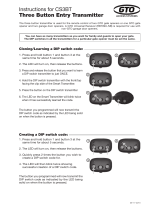 GTO Access Systems I6HGD03BTXL User manual
GTO Access Systems I6HGD03BTXL User manual
-
Mighty Mule F4100MBC Installation Instructions Manual
-
GTO FM137-G3 Instructions Manual
Other documents
-
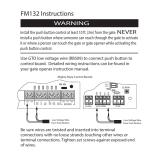 Mighty Mule FM132 Operating instructions
Mighty Mule FM132 Operating instructions
-
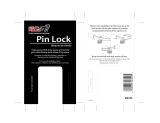 Mighty Mule FM133 Owner's manual
Mighty Mule FM133 Owner's manual
-
Mighty Mule FM136 Installation guide
-
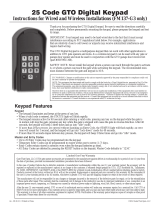 Mighty Mule 350 User manual
Mighty Mule 350 User manual
-
Shenzhen Jos Technology MC-803 Operating instructions
-
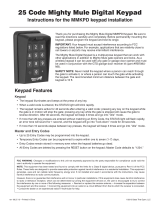 Mighty Mule MMKPD Operating instructions
Mighty Mule MMKPD Operating instructions
-
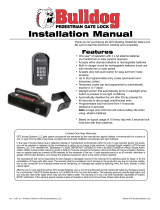 Mighty Mule FM145 Installation guide
Mighty Mule FM145 Installation guide
-
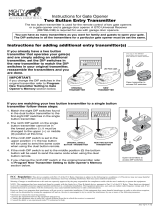 Mighty Mule MM3BT Installation guide
Mighty Mule MM3BT Installation guide
-
Topens TC188 User manual
-
 Mighty Mule FM135 Installation guide
Mighty Mule FM135 Installation guide












